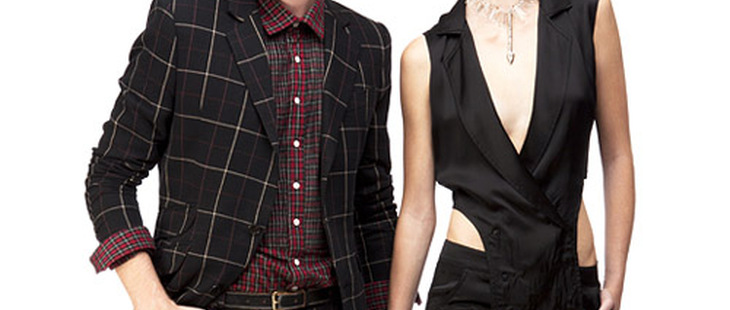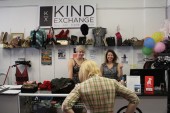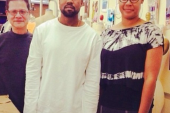
 (Photos: Kyriakos)
(Photos: Kyriakos)
See “In Pictures: Philip Sparks v. Chloe Comme Parris”
Among indie Toronto fashion lines with the potential for serious brand-dom, few are more promising than these two: Philip Sparks and Chloe Comme Parris. Sparks,29, has been showing for nine seasons and is by now a Toronto institution. There is a kind of local man who wears boat shoes til December and gets old-fashioned shaves and vintage tattoos, and that man owes a lot to Philip Sparks. Women, too, love the cut of his jib: a year ago Sparks intro’d clothes pour femme by popular demand. He also has a line of bags and shoes, made in collaboration with Town Shoes. There is a Philip Sparks way of looking—usually backwards, fondly—that has turned his name into a thing.
Chloe and Parris Gordon, aged 23 and 21 respectively, have only done three collections. Yet they already make bona fide it-bags that retail at luxury prices, alongside tough, beautiful, Victorian-girl-gone-wild clothing and soft-rock jewellery. Next on their minds? Nail polish and shoes, but of course. They’re the most exciting new designers I’ve seen since, well, Philip Sparks.
The Sparks aesthetic is very ’40s or ’50s girl-meets-boy, but fresh. Chloe Comme Parris is more like girl-screws-boy-and-cuts-up-his-clothes-to-make-dresses. In a Toronto Standard shoot with photographer Kyriakos and stylist Amy Lu we celebrated those differences—and important similarities, like strong tailoring and historical references. Afterward, I sat down with Philip, Chloe and Parris and let them talk about everything that matters to young designers: identity, brand-building, quests for esoteric inspiration, the hardships of producing locally, and the best cheap lunches when you’re waiting forever to get paid.
See “In Pictures: Philip Sparks v. Chloe Comme Parris”
__
SNP: Let’s talk about how you started. Philip, you started earlier.
PHILIP: I worked all over the place first, in theatre mostly. Fashion is always what I really wanted to do, but I got really good exposure and met really cool people and learned things I never would have learned if I had just been with regular sort of fashion companies. I worked for the National Ballet for about three years, I worked for the Canadian Opera Company for a year, and then I worked for three years in the design department for the Stratford festival. I was really young when I started working at Stratford and living through Stratford in the winter wasn’t what appealed to me at that point of my life. I decided to make a collection and I met the right people and we had a show and we made a buyers list and started selling the collection. What about you guys?
CHLOE: Parris and I always knew we wanted to do something creative together from a young age, but we didn’t really know what it would turn out to be. I went to Dalhousie and started in the costume program, doing stuff in the theatre, just learning my skills. Through that I found out about NSCAD and applied there and got in and just really started working in the textile program. Parris and I are two and a half years apart, so once she visited me and saw NSCAD, it really started to inspire her.
PARRIS: I remember you had to do a portfolio to apply and one of the questions was design an object, and I designed a watch. I’ve always been an accessories person and when I went to NSCAD, I started in the jewellery program. It was a challenge—insane, chaotic—but I loved it. I had a lot of pieces, and Chloe had clothes, and then we did a photo shoot and put things together and ever since then we’ve been making collections.
CHLOE: My last year in school, which was Paris’s second year, we showed in Toronto Fashion Week and that was when we met The Fashion Collective and invited buyers and things escalated from there.
PHILIP: It’s funny, it always starts very organically. You want to have a perfect business plan, but all you know is that you’re doing work that you love, and if you’re doing it and out meeting people, then the right sorts of things happen at the right time and the next thing you know, you’re shipping orders.
CHLOE: I moved home from university and all of a sudden we were in production!
PHILIP: Do you ever curse yourself at three o’ clock in the morning through production when you realize you put too much detail on something and you gotta ship out?
CHLOE: Yeah, totally. I feel the need to put a million buttons on something, and then I seem to always get the buttons that can’t be stitched on by machine, that you have to hand-tack, and I’m like why do I do this.
SNP: I’m really interested in what you can do in Toronto, what you can’t do in Toronto, where you get all your different fabrics, what percentage of materials you can source here? And how important is it to produce lovely stuff like that locally, as much as possible?
CHLOE: I’m such a prints person, from studying textiles, like how to weave fabrics together, dye and print. So I create and design my own prints and have them locally screen-printed, except this season we really wanted to print on a lot of fabrics that you can’t screen-print by hand, like chiffon. So we’ve had to outsource to Montreal for digital printing, and also we’re getting stuff from Europe now through different fabric retailers. I find that it’s really hard in Toronto sourcing good materials when you wanna be in the high end market. Everyone has the same stuff. When I see shows at Toronto Fashion Week, I can tell where they bought their fabrics.
PARRIS: I think for us it’s like the best quality, the closest we can find it. We’re very much for producing locally, manufacturing here, but you know we’re not going to use shit fabrics just for the sake of saying it’s from Toronto.
PHILIP: And how much of it [fabrics] is actually made here, you know? You might have bought it here but it doesn’t mean it’s made in Toronto. It’s been thirteen years since I started going to school here, and back then this whole stretch of Queen West past Spadina was fabric stores. One by one they started closing down or turning to drapery, upholstery and special occasion fabrics for like things like bridesmaids. I like to stay as local as possible, too, but in terms of fabric it’s near impossible. And when you get into knits, it costs more to get the yarn here than it does to have a whole sweater made somewhere else.
CHLOE: Knitwear is ridiculous, it can’t be done here. I know we want to start doing our own custom knits and that’s going to be an issue, cause we’re definitely going to have to go and produce somewhere else.
PHILIP: It’s nicer when you can develop it here, because you have more creativity around it.
Page 2 of 3
SNP: Both of you started doing accessories so quickly. How many seasons did it take you, Philip, before you introduced bags and the shoes?
PHILIP: We introduced shoes in our second season and bags—I’m not sure. We always made smaller accessories, not like full extensive accessory collections. But we’ve always tried to build everything for a collection, everything that’s part of a look, instead of pulling those pieces from elsewhere.
CHLOE: We feel the same. Even finding shoes for a runway show, you get the best you can find, but you’re not really happy with it.
PARRIS: I think we have all we can handle right now: a full line of clothing, a full line of jewelry, now bags. But, yeah, dying to do shoes.
PHILIP: I do mine in collaboration with Town Shoes. Collaborations are really important, not just for small designers. You see some of the biggest fashion houses in the world doing collaborations with people like H&M. Inevitably you’re getting your name out there right?
CHLOE: Yeah, making more connections.

PHILIP: Making more connections with people on a different level. Connecting with people who maybe haven’t heard of your brand, because they don’t shop at that price point yet, and they sort of fall in love with what they see and they have something to aspire to. I think it’s a healthy thing and it’s good for the industry for the sort of big-box, fast-fashion people to be working with the more artistic side of the industry instead of just always knocking it off.
CHLOE: Did you feel like when you did the collaboration that you could still have your full vision, or did you have to compromise?
PHILIP: I mean it all depends on what you’ve negotiated for yourself, but I find for the most part, companies want to work with you because they know that you’re talented and that they want to incorporate as much of what you’re doing as possible.
SNP: Who would you collaborate with if you could choose?
CHLOE: In terms of fast fashion? I don’t know, maybe an H&M or a Zara.
PARRIS: I was going to say Opening Ceremony.
PHILIP: That’s a different kind of collaboration.
SNP: Dream big, I like that.
PARRIS: If it’s fast fashion, then yeah, like a Zara. Does Zara even do that?
SNP: I don’t think so. Topshop is good, they’ve done smaller designers in the Topshop Edit thing. Now that they’re here in Canada, I kind of hope they reach out to Canadian designers, but I have no idea. This is just speculation.
CHLOE: We’ll see!
SARAH: How conscious are you of building a brand? From shows to social media, there are now all of these channels for designers, and each seems like it can make or break you. I feel like that must be confusing.
PARRIS: We’re really concerned with our look, like having a completely different vision and aesthetic and inspiration for each collection, but then incorporating elements that people have seen in our previous collections. I think that’s how we’re looking at branding right now. So when you’re looking at a CCP garment, it’s going to have an interesting cut or do up a different way, or let’s say we’ve been doing long backs, or something like that.
CHLOE: We’ve always been very ambitious with our brand. We look at Vogue magazines from the ’60s to Vogues now and see how a brand has evolved, see what elements they’ve kept similar and what they’ve changed. I admire Givenchy a lot, I admire Yves Saint Laurent, Proenza Schouler. I think Proenza Schouler has been a huge inspiration for Parris and I.
SNP: What about you, Philip?
PHILIP: I never like to divulge that information. I like to sort of keep it all close to my heart. It’ll sound really clich because he did just pass away, but Alexander McQueen was somebody that I looked up to, initially. His dad was a cab driver, he wasn’t living in the best part of London, he didn’t come from a ton of money, but he did something because he had passion for it and he loved it and he worked really hard at it. He worked at the National Theatre [ed note: he worked at theatre costumier Angels & Bermans] for some time, he worked on Savile Row, then he went to Central Saint Martens. I found it very inspiring that he was able to pursue what he loved without coming from any sort of privileged place.
SNP: It’s interesting that you brought that up. There’s a perception, in New York for example, that Parsons is great and has the best graduates and blah blah blah. No one ever mentions that it’s an extremely expensive school, the kids are rich, so they’re more likely to get or have the money to start a line. And of course that’s going to make the success rate of Parsons grads higher. So, because I know neither of you had enormous resources when you started, how did you raise the first thousands of dollars just to buy fabrics and so on?
PHILIP: I used my own money, applied to every credit card I could get, and got some government help because I was starting a business under a certain age. My parents aren’t, you know, very privileged but were able to co-sign my loans.
CHLOE: In my second year of university, I became really serious about fashion and I started to hand-make leather and feather jewelry. We had pheasants on our property, so I just plucked their feathers and used them. Everyone in Halifax and on the East Coast just went crazy over it, and I made a ridiculous amount of money.
PARRIS: People still send emails, like can I get a pair of feather earrings for my sister? That was like three years ago. We shouldn’t even make them…
CHLOE: But I still do, for money on the side.
PARRIS: Cause it’s easy for you.
CHLOE: When I was in school making garments, I just started making four or five of something. Like a woven dress, or something that I printed and sewed. We sold to boutiques in Halifax. We raised a ton of money, and as we’ve been going we’ve been making money, and we do have our parents helping us out, but not a ton. We’re really just living paycheck to paycheck.
PHILIP: And they’re not even paychecks. They’re far more spread apart than that.
CHLOE: I find waiting to be paid the hardest part. The gap between the forking out of the money for production, and then the delivery, in that time I’m always getting two-dollar sandwiches at the Portuguese bakery on Ossington.
PHILIP: At the falafel place on Queen you can get two falafel sandwiches for three dollars. You can have lunch for two days.
CHLOE: At the Portuguese bakery, their day-old bread, they’ll have like ten buns in a bag for 99 cents. Food for the week!
SNP: Oh my god, the glamour is actually killing me.
Page 3 of 3
CHLOE: So, Philip, how was the transition going from mens to womens?
PHILIP: I wasn’t going to do womenswear, I just wanted to focus on a men’s line. I had a lot of women buying our menswear, and the cut for women didn’t work out the same way. Even if you want to go for sort of a “boyfriend” look, if you will, it doesn’t translate fit-wise. I was ready for a new challenge, and so we decided to do womenswear.
CHLOE: Do you find one more challenging than the other?
PHILIP: I did women’s costume, and I studied womensear more intensively at school, so I understand it. But just because I’ve been doing menswear for so long, when I started doing womensear it was like starting from scratch, building blocks up again, There was a lot of research involved with it.
SNP: I came in for some sessions.
PHILIP: I put together a panel of people and I said “you’re all people who have said that you want me to do women’s clothing and like what is it about what we’re doing that you like.” I was happy to find out that they didn’t just want the womenswear version of every menswear piece, they just liked the aesthetic that we were doing and they wanted to be able to buy into that, so that’s what we did.
CHLOE: I find I’m starting to get the same thing. Guys are wanting certain jackets that I’ve done, because I’m like more of a tomboy, so a lot of my womenswear comes from more of a masculine place—to start with, at least. I’m doing my first custom jacket for one of my good friends this season and I’m like building a block and starting there.

PARRIS: Someone recently did a shoot with all our fall line, all on guys. It looked awesome.
CHLOE: He was wearing women’s shorts and women’s blouse and a backpack. Though I would be never be one to do unisex clothing, I do think more and more there are things that transcend the sexes. Like a great button-up shirt, and you just change the cut but keep your aesthetic
SNP: People mix up “unisex” and “androgynous” all the time. Chloe, you guys are actually doing androgyny because it’s combining masculine and feminine elements. That’s really the actual definition of androgyny, having both masculine and feminine qualities, but the way that it’s perceived often, the way that certain people design, is to create a garment that has neither, and it’s just like a sexless black drapey thing. Which I think is so boring, so I like the way that you approach it. For you, Philip, it seems more nostalgic, for a time when gender was more clearly delineated in dress. But then how do you try to make that modern?
PHILIP: It’s a funny thing, in one word that’s how I would describe our collection: nostalgic. Sort of referencing the past. I’m sure you’ve all gone vintage shopping, most people that are really interested in fashion go vintage shopping on a regular basis, I still love going too. But when you go and you do that there’s always something about a vintage piece that’s just not right anymore. I’m trying to take those ideas and make them work for now.
CHLOE: Yeah, Parris and I both look at history a lot for inspiration and I find the detailing and the overall thought is amazing, but you have to reduce the silhouettes. Right now we’re really into the Victorian era, but I’ve looked back to the 14th century. My mom’s biggest inspiration is Louis the 14th, so that whole era is a huge inspiration for me. We’re kind of stuck in that.
PHILIP: I go from late Victorian to ’60s. And late Victorian, more referencing menswear. Not bustles or trains or hoop skirts…
CHLOE: It’s funny, cause men did dress quite feminine.
PARRIS: They were wearing heels.
PHILIP: I love early photography of regular people. It’s not so much old illustrations or paintings, it’s like I love finding old photographs of normal people and how they dressed.
CHLOE: I know, but they’re hard to find. What I mostly find is the books before photography, and they were sketching what was going on, what people were wearing, I really like looking at that element just because I love the art of it and the idea of someone recreating a moment.
PHILIP: You can find a lot of that stuff at St. Lawrence Market, but you have to spend a whole day. And every time I’m in New York I go to the Strand bookstore, to the photography section, and find something that hasn’t made its way here yet.
SNP: What’s your secret Toronto resource, where do you go?
CHLOE: Definitely my mom’s archives. I also go to the Toronto Reference Library. You can’t take anything out so you just sit there, you’re in a completely different mentality, you just sit and go through things.
SNP: It’s been interesting for me to see how superficially different your lines are, but then how similar certain processes are, even the theatre background, and the research methods.
PHILIP: Yeah, it’s the same process right, inevitably.
SNP: Well, I don’t know if all designers go to the library.
See “In Pictures: Philip Sparks v. Chloe Comme Parris”
__
Sarah Nicole Prickett is the Toronto Standard Style Critic.














